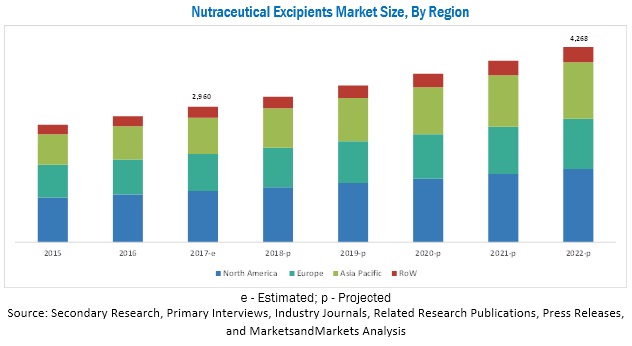The nutraceutical excipients market is estimated at USD 2.96 Billion in 2017, and is projected to reach a value of USD 4.27 Billion by 2022, at a CAGR of 7.6%. The market is segmented on the basis of functionality, end product, form, and region. The functionalities of nutraceutical excipients include binders, fillers & diluents, disintegrants, coating agents, flavoring agents, and lubricants. On the basis of end product, the market is segmented into prebiotics, probiotics, proteins & amino acids, vitamins, minerals, and omega-3 fatty acids. The market has been segmented on the basis of form into dry and liquid. On the basis of key regions, the nutraceutical excipients market has been segmented into North America, Europe, Asia Pacific, and the Rest of the World (RoW).

Growing demand for nutraceuticals
Globally, the burden of chronic diseases is rapidly increasing. According to the WHO, in 2015, chronic diseases caused about 3 million deaths, accounting for 5% of all deaths in the year, globally. In addition, the proportion of the burden of non-communicable diseases (NCDs) is expected to increase to 57% by 2020. Moreover, according to the National Center for Chronic Disease Prevention and Health Promotion, in 2012, about 117 million people in the US had one or more chronic health condition and one of four adults had two or more chronic health conditions.
Download PDF Brochure:
https://www.marketsandmarkets.com/pdfdownloadNew.asp?id=247060367
Advances in nanotechnology imparting new functions to excipients
Nanotechnology-enabled drug delivery systems (NDDS) are used to tackle the issue of drug toxicity. There are two major approaches in using nanotechnology as a drug delivery system (DDS). The first is to reduce the size of nutraceutical drug crystals to ensure greater solubility and bioavailability, while the second approach is using some form of nano-carrier for the more effective delivery of the active ingredient.
Poor drug physiochemical properties can be improved by associating the drug with a pharmaceutical carrier. A drug delivery system (DDS) can enhance a drug’s pharmacokinetics and cellular penetration. Moreover, drug delivery system (DDS) may also address obstacles arising from low drug solubility, degradation, fast clearance rates, nonspecific toxicity, and inability to cross biological barriers. Hence, the use of nanotechnology in improving the functionality of excipients is also expected to drive growth of the nutraceutical excipients market.
Dry excipients accounted for the largest market share among all forms in 2016.
The dry form of nutraceutical excipients accounted for a larger market share, as compared to the liquid form. The popularity of the dry form can be attributed to its cost-effectiveness and convenience in multiple applications. Increase in demand for dry beverage mixes with additional nutrients, including customized mixes, and consumer preference for fortified beverages are fueling the growth of the dry segment in the nutraceutical excipients market.
Request for Customization on this Report:
https://www.marketsandmarkets.com/requestCustomizationNew.asp?id=247060367
North America dominated the nutraceutical excipients market in 2016.
North America accounted for the largest market share in 2016. The nutraceutical excipients market is consolidated in North America and dominated by a few companies such as DuPont, Kerry, Cargill, and Ingredion. The market for nutraceutical excipients here is mature, and hence, the growth is moderate compared to other regions.
This report includes a study of marketing and development strategies, along with the product portfolios of the leading companies. It includes profiles of leading companies such as Kerry (Ireland), ABF (UK), DuPont (US), Ingredion (US), and Sensient (US), Roquette Frères (France), Meggle (Germany), Hilmar Ingredients (US), JRS Pharma (Germany), Innophos (US), Cargill (US), and IMCD (Netherlands).